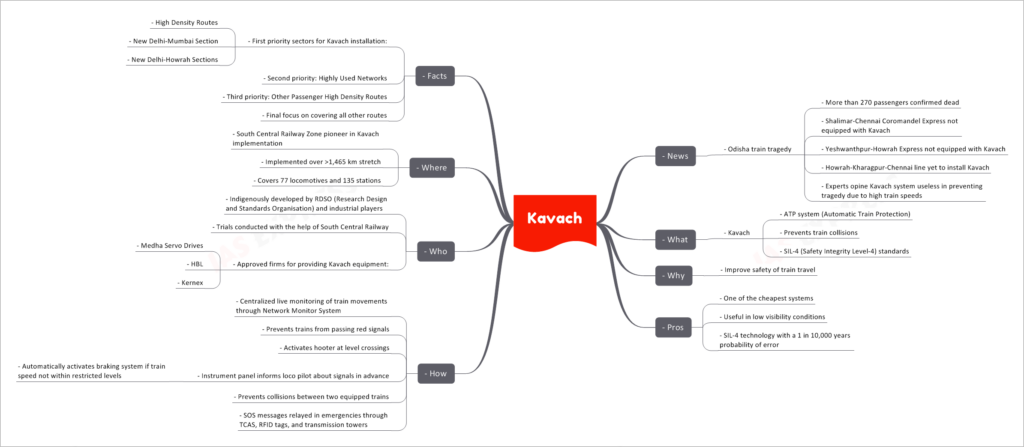Kavach


News:
- More than 270 passengers confirmed dead in the Odisha train tragedy.
- Neither the Shalimar-Chennai Coromandel Express, not the Yeshwanthpur-Howrah Express were equipped with Kavach. The system is yet to be installed on the Howrah-Kharagpur-Chennai line.
- However, experts have opined that given the high speeds of the trains, even the Kavach system would have been useless in preventing the tragedy.
What:
- Kavach is an ATP (Automatic Train Protection) system.
- It is a system for preventing train collisions.
- This electronic system has SIL-4 (Safety Integrity Level-4) standards.
Why:
- To improve the safety of train travel.
Pros:
- One of the cheapest systems.
- Especially useful in conditions of low visibility.
- SIL-4 technology means the probability of error is a mere 1 in 10,000 years.
How:
- It enables centralized live monitoring of train movements through the Network Monitor System.
- It prevents trains from passing a red signal.
- It automatically activates the hooter when approaching level crossings.
- The instrument panel informs the loco pilot about the signal in advance, even before visual sighting. It automatically activates the braking system if the loco pilot fails to keep the train speed within the restricted levels.
- When 2 trains are equipped with this system, collisions between them can be prevented.
- It relays SOS messages in case of emergencies. The traffic collision avoidance system (TCAS), the on-board equipment in the train and the transmission towers of the station with the RFID (Radio Frequency Identification) tags enable the 2-way communication between the loco pilot and the station master.
Who:
- It was indigenously developed by RDSO (Research Design and Standards Organisation) along with the industrial players.
- Trials were carried out with the help of South Central Railway.
- Firms approved for providing Kavach equipment:
- Medha Servo Drives
- HBL
- Kernex
Where:
- The South Central Railway Zone is the pioneer in Kavach implementation.
- It has been implemented over a stretch of > 1,465 km in this zone.
- It covers 77 locomotives and 135 stations.
Facts:
- In near future, Kavach is to be first installed in some 1st priority sectors:
- High Density Routes
- New Delhi-Mumbai Section
- New Delhi-Howrah Sections
- Second priority accorded to Highly Used Networks.
- Third priority accorded to other Passenger High Density Routes.
- Finally, the focus would be turned to cover all other routes.
MCQ:
Consider the following statements:
Statement-1: The Kavach system is effective in preventing train collisions at high speeds.
Statement-II: Kavach enables centralized live monitoring of train movements through the Network Monitor System.
Which one of the following is correct in respect of the above statements?
(a) Both Statement-1 and Statement-II are correct and Statement-II is the correct explanation for Statement-1
(b) Both Statement-1 and Statement-II are correct and Statement-II is not the correct explanation for Statement-1
(c) Statement-1 is correct but Statement-II is incorrect
(d) Statement-1 is incorrect but Statement-II is correct
Answer: (b) Both Statement-1 and Statement-II are correct and Statement-II is not the correct explanation for Statement-1
Explanation: Statement-1 states that the Kavach system is effective in preventing train collisions at high speeds, which is supported by the information provided in the “How” section of the text. The Kavach system prevents trains from passing red signals, activates the hooter at level crossings, and relays SOS messages in case of emergencies. These features contribute to the prevention of collisions between trains. Statement-II mentions that Kavach enables centralized live monitoring of train movements through the Network Monitor System. This statement is also true, as mentioned in the “How” section. However, Statement-II does not explain why the Kavach system is effective in preventing train collisions at high speeds. Therefore, the correct answer is option (b).
If you like this post, please share your feedback in the comments section below so that we will upload more posts like this.

